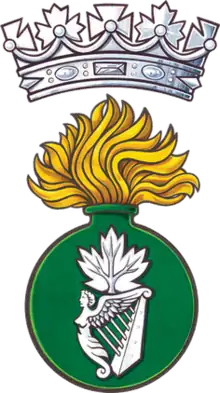The Irish Fusiliers of Canada (The Vancouver Regiment)
The Irish Fusiliers of Canada (Vancouver Regiment) was an infantry regiment of the Canadian Army.
| The Irish Fusiliers of Canada (The Vancouver Regiment) | |
|---|---|
 | |
| Active | 1913–1965 |
| Country | |
| Branch | Canadian Army |
| Type | Infantry |
| Size | One battalion |
| Regimental Headquarters | Vancouver |
History
The Irish Fusiliers of Canada (Vancouver Regiment) was formed in Vancouver, British Columbia on 15 August 1913 as the 11th Regiment Irish Fusiliers of Canada. The regiment was redesignated The Irish Fusiliers of Canada on 12 March 1920 and reorganized as a two battalion regiment with the 1st Battalion perpetuating the 121st Battalion (Western Irish), CEF and a 2nd Battalion on the Reserve order of battle. The reserve unit was disbanded on 14 December 1936.[1]
On 1 June 1936 the Irish Fusiliers of Canada were amalgamated with The Vancouver Regiment and were redesignated the Irish Fusiliers (Vancouver Regiment). It was redesignated as the 2nd (Reserve) Battalion, Irish Fusiliers (Vancouver Regiment) on 1 January 1941 and the Irish Fusiliers (Vancouver Regiment) on 1 June 1945. The regiment was converted to artillery and redesignated the 65th Light Anti-Aircraft Regiment (Irish Fusiliers), Royal Canadian Artillery on 1 April 1946. On 1 September 1958 the regiment amalgamated with the 120th Independent Field Battery, RCA, converted to infantry and redesignated the Irish Fusiliers of Canada (The Vancouver Regiment).[2]
The 120th Independent Field Battery, RCA originated in Prince Rupert, British Columbia on 1 May 1914 as the Earl Grey's Own Rifles. It was redesignated as the 68th Regiment (Earl Grey's Own Rifles) on 2 November 1914 and as The North British Columbia Regiment on 12 March 1920. Upon redesignation as The North British Columbia Regiment it was organized as a two battalion regiment with the 1st Battalion perpetuating the 102nd Battalion, CEF and the 2nd Battalion, perpetuating the 30th Battalion, CEF, on the Reserve order of battle. The reserve unit was disbanded on 14 December 1936.[3]
On 15 December 1936 the North British Columbia Regiment was converted to artillery and redesignated as the 102nd (North British Columbia) Heavy Battery, RCA. During the Second World War it was redesignated as the 102nd (Reserve) (North British Columbia) Heavy Battery, RCA on 1 January 1941 and as the 120th Coast Battery, RCA on 1 April 1946. Following the Second World War, the unit was redesignated again as the 120th Heavy Anti Aircraft Battery, RCA on 5 February 1948, as the 120th Harbour Defence Troop, RCA on 17 October 1954 and the 120th Independent Field Battery, RCA on 25 October 1956. On 1 September 1958, it was amalgamated with the 65th Light Anti-Aircraft Regiment (Irish Fusiliers), RCA.[4]
The Vancouver Regiment originated in Vancouver, British Columbia on 15 May 1924 when the 1st British Columbia Regiment (Duke of Connaught's Own) was reorganized into three separate regiments designated the 1st British Columbia Regiment (Duke of Connaught's Own), The Westminster Regiment and The Vancouver Regiment. On 1 June 1936, it was amalgamated with The Irish Fusiliers of Canada.[5]
The Irish Fusiliers of Canada (The Vancouver Regiment) were reduced to nil strength and transferred to the Supplementary Order of Battle on 19 March 1965. On 13 June 2002, it was removed from the Supplementary Order of Battle and amalgamated with The British Columbia Regiment (Duke of Connaught's Own).[6]
The Regiment is perpetuated by 2381 British Columbia Regiment Irish Fusiliers Royal Canadian Army Cadet Corps in Richmond, B.C.
References
- Canadian Forces Publication A-DH-267-003 Insignia and Lineages of the Canadian Forces. Volume 3: Combat Arms Regiments.
- Canadian Forces Publication A-DH-267-003 Insignia and Lineages of the Canadian Forces. Volume 3: Combat Arms Regiments.
- Canadian Forces Publication A-DH-267-003 Insignia and Lineages of the Canadian Forces. Volume 3: Combat Arms Regiments.
- Canadian Forces Publication A-DH-267-003 Insignia and Lineages of the Canadian Forces. Volume 3: Combat Arms Regiments.
- Canadian Forces Publication A-DH-267-003 Insignia and Lineages of the Canadian Forces. Volume 3: Combat Arms Regiments.
- Canadian Forces Publication A-DH-267-003 Insignia and Lineages of the Canadian Forces. Volume 3: Combat Arms Regiments.